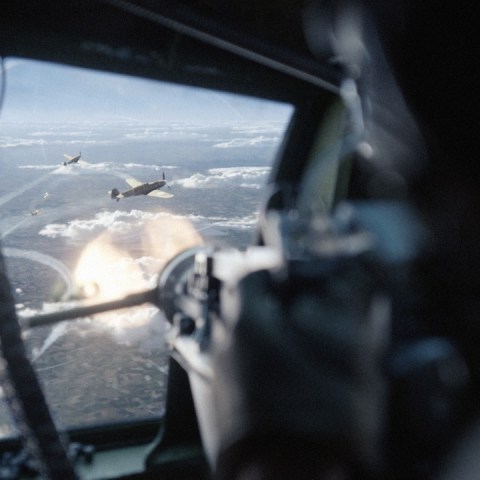Behind the scenes with VFX studio DNEG on digital environments and invisible effects.
Rian Johnson’s Glass Onion: A Knives Out Mystery, now streaming on Netflix, mostly takes place on the private island of billionaire Miles Bron (Edward Norton), complete with an intricate ‘Glass Onion’ structure. Except, of course, that location did not really fully exist.
It was up to the film’s visual effects team to flesh out island views, build the Glass Onion in CG itself based on artwork and on-set builds, and then destroy it. (And yes, those interior shots filmed on bluescreen with a crazy amount of glass were a challenge).
Here, DNEG visual effects supervisor Sameer Malik and DNEG executive producer Philipp Wolf tell befores & afters about the many invisible effects their studio was responsible for in the film, including a few surprising ones.


b&a: What’s so great about the VFX in this film is that they are largely so invisible—what kind of conversations did you have with the filmmakers about the ‘style’ of visual effects work required here?
Sameer Malik: The communication about the asset design was made clear to us from the beginning. Every asset had a different requirement to its look, but we had a design brief and concept art to work from for the Glass Onion, Villa and Aerospace factory. From there, we needed to make sure that the Glass Onion complimented the Villa, and that the two assets married together in a coherent way.
Philipp Wolf: The goal from the beginning was for the visual effects to seamlessly integrate into the film and enhance the storytelling while keeping control of specific elements in the scene. Visualising the autostereogram on the puzzle box was one of those challenges where visual effects came in to help the narrative.
b&a: For the Glass Onion glass structure itself, can you talk about the evolution of the design process for this, in terms of what you received from the art department, whether any maquettes were made, and what particular challenges there were in realizing the building as glass?
Philipp Wolf: The design of the Glass Onion structure was defined from the moment we got involved in the project. Based on concept art and the on-set builds, our team rebuilt the structure and its interior. From a production perspective, the biggest challenge was to render such a reflective and refractive structure and to ensure it properly sat in the different light situations of the provided plates.
Sameer Malik: The daytime exterior shots were a real challenge! We had to find the right index of refraction and transmission in order to show the reflection of the environment. We tested the IOR (Index of Refraction) value under the different transmission values within the context of each shot to find the right balance.


b&a: For interior scenes inside the Glass Onion, how were these filmed? What were the tougher tasks of compositing the glass structure and backgrounds into live-action scenes?
Philipp Wolf: The interior scenes of the glass onion were filmed on a bluescreen set with a partial glass structure in-between the actors and the blue screen. Assuring the exposure balance of the VFX island environment and the foreground plate and its reflections on the glass was certainly a challenge.
Sameer Malik: As Philipp said, the interior scenes were shot using blue screens and a partial glass structure. But the onset structure didn’t have a top portion to close the Glass Onion’s shape, so we needed to create a fully CG onion structure in order to replace the onset version when needed, based on the shot requirements. Also, the Glass Onion interior scenes were shot with stage lighting in the studio which caused a lot of reflection on the glass. In order to keep the shots, we re-redendered the full CG asset to capture the right daytime reflection from our Greece environment and then roto’d the characters and objects in.


b&a: When the explosion and fire occurs, what elements could be achieved practically, and what did DNEG need to add here?
Sameer Malik: We had no visual reference for the fire shots. The scenes were shot at dusk with no fire elements, so we had to create the light interaction, fire sims, fire jets and main explosion from scratch. 90% of the fire was rendered in Houdini, with the interactive layout generated in Clarisse. The fire and explosion shots were some of the toughest as we had to find the right balance between it looking large and impressive – but also not dangerous. The director, Rian Johnson, was looking for a ‘Caddyshack’ moment for the final explosion. We rendered over 15 FX sims until we found the one that fit his vision.
Philipp Wolf: Production was able to add interactive light to the villa which served as the base of Miles’ island home. We ended up replacing big parts of the original villa for more control of the interactive light and shadows.
b&a: What might be a particular shot, or sequence, where you think audiences may not have realized the environment was synthetic, or there were invisible effects being utilized at all?
Sameer Malik: When they meet Miles and he showcases the Glass Onion, the villa and environment behind Benoit Blanc is entirely CG. We also created the environment behind any poolside shots, and the interior Atrium shots showcasing the extractor, even down to the floor right before the fire destroys everything.
Philipp Wolf: That is an easy one, Miles driving his Porsche. The car was full CG!






























